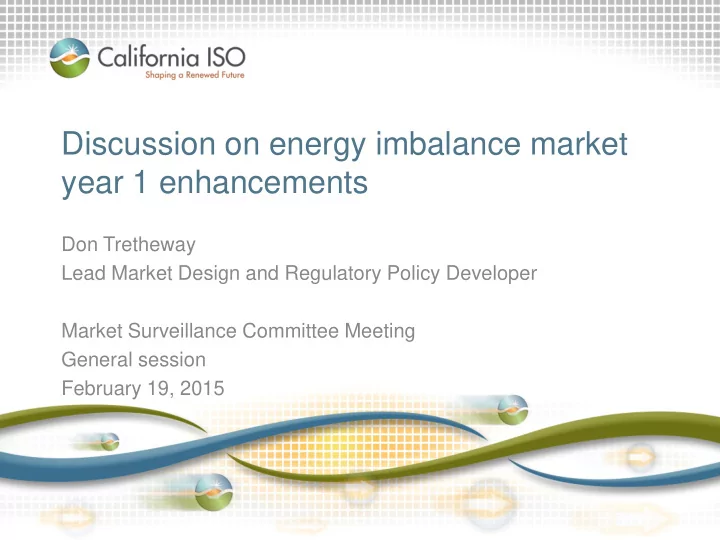

Discussion on energy imbalance market year 1 enhancements Don Tretheway Lead Market Design and Regulatory Policy Developer Market Surveillance Committee Meeting General session February 19, 2015
Phase 1 items planned for Board decision in March 2015 • Settlement of non-participating resources • Administrative pricing rules • Add base schedule import/export decline to resource sufficiency evaluation • Resources sufficiency evaluation applied to ISO BAA • EIM administrative charge redesign • Reduce flexible ramping constraint combinations • GHG flag and cost based bid adder • Modification of EIM transfer limit constraints – Establishment of EIM transfer limits using ATC Page 2
Updated GHG proposal provides more flexibility and maintains the “flag” concept • On an hourly basis, submit single MW quantity and price by resource that can receive GHG award – GHG MW quantity and price is independent of bid range • The “flag” is equivalent to bidding 0 MW – If SC does not submit a GHG MW bid, the default will be zero • EIM transfers into ISO from all EIM BAAs can be no greater than total MW of GHG bids – If EIM transfers are limited by GHG bids will consider long term design change in Phase 2 Page 3
ISO will calculate a daily maximum GHG bid allowed by resource • Similar to how ISO calculates GHG cost to be included in ISO resource’s default energy bid – However, ISO calculates a cost curve based upon incremental heat rates to align with multi-segment bid curve • Daily maximum GHG bid = max heat rate * GHG allowance price index * GHG emissions rate + 10% • Scheduling coordinator can bid on an hourly basis less than its daily maximum GHG bid • If a MW quantity is submitted, but no price, the daily maximum GHG bid will be used by default Page 4
EIM Transfer Constraints (Current) PACW PACE PACE Transfer Limit PACE_PACW CISO Transfer Limit Page 5
EIM Transfer Constraints (Future) Non-EIM EIM BAA EIM BAA BAA Non-EIM CAISO EIM BAA BAA Non-EIM EIM BAA EIM BAA BAA Page 6
Energy Transfer Schedule Definition • Portion of the EIM Transfer distributed to an intertie (or between tags on the same intertie) with another BAA in the EIM area for accounting and tagging • Constrained by energy transfer limits – Limits reflect transmission rights released for EIM • Limits may be 15 min static (RTUC) and 5 min dynamic (RTD), or only 5min dynamic (RTUC/RTD) – If using contractual rights, provided by EIM entity – If using ATC, calculated with priorities provided by EIM entity • Constrained by scheduling limits (ISL/ITC) on interties with California ISO or non-EIM BAAs Slide 7
Transfer cost ensures unique solution and most direct path is used to tag EIM transfers 100 MW BAA BAA #1 #2 100 MW 100 MW BAA BAA #3 #4 100 MW 3x to tag on green path, than the red path Page 8
Transfer cost allows implementation of priority order of which tags to schedule EIM transfers • Direct paths will have higher priority over indirect paths • Paths that 5-minute scheduling is allowed on will have different priority over paths that only 15-minute scheduling is allowed on • Paths with firm transmission will have higher priority over paths with non-firm transmission • Paths that experience less-frequent curtailments will have higher priority than paths with more-frequent curtailments Page 9
Transfer cost used in market will balance the benefits with minimizing impact to LMPs • Based on simulations, the ISO will propose a maximum transfer cost allowed • The maximum transfer cost will be in the ISO tariff • EIM entity can provide priority of tags, the ISO will determine the transfer cost used to implement priority Page 10
Phase 2 items informed by six month of operational experience or need additional discussion • 15-minute bidding on intertie scheduling points • Additional sub-allocation of RTCO (flow entitlements) • EIM transmission charge • Dynamic market power mitigation • Additional transition period measures • Long term changes to GHG design • Other items identified during implementation Ability to bring design changes for Board decision before 1 year of operational data Page 11
Recommend
More recommend